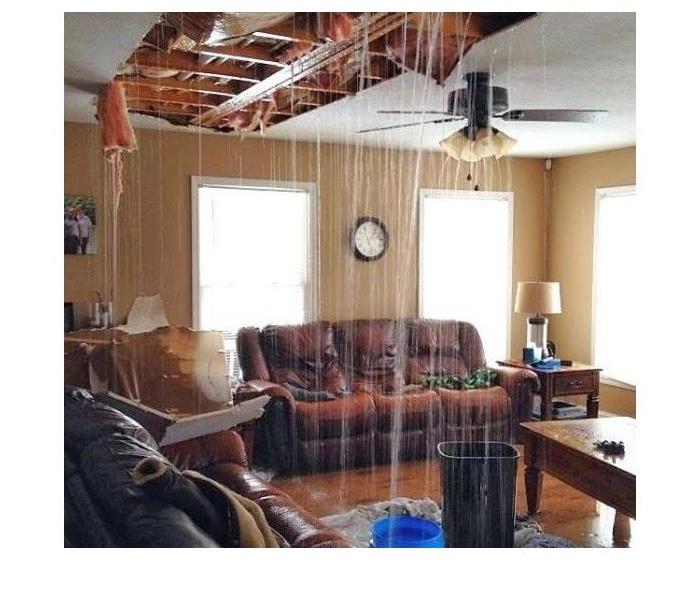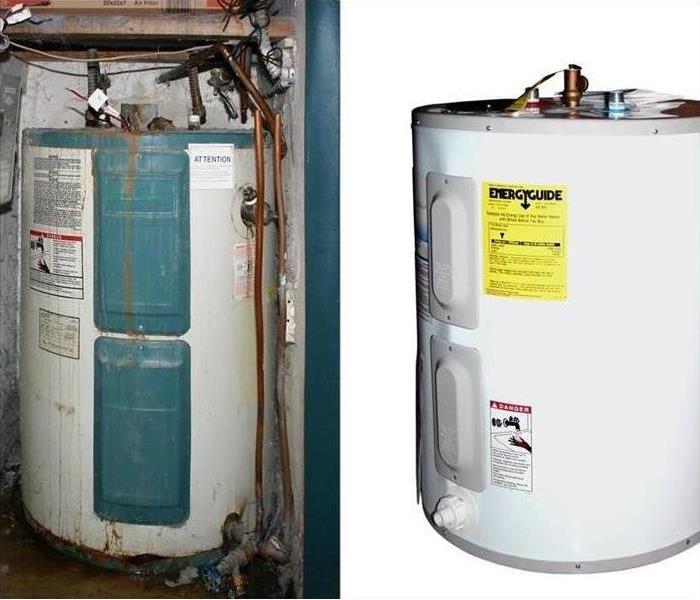Archived Water Damage Blog Posts
Don’t Come Back From Vacation to Find Your San Antonio Home Flooded
10/8/2023 (Permalink)
The last thing that should be on your mind when you’re on a vacation away from San Antonio, TX is whether a broken pipe has caused an area of your home to flood. This can cause damage to your belongings and your home, so the best thing to do is to prevent the need for water pipe repair.
Prevent Burst Pipes
Broken pipes can be difficult to fix, and the damage can be costly. It’s best to keep this issue from ever happening. If you’re traveling out of town for an extended period of time, specifically during the winter, there are several steps you can take to prevent your home from being flooded:
• Don’t turn down the heat too far. If you keep the heat on, even if you turn it lower than if you were home, it can keep your pipes warm enough to prevent them from freezing.
• Keep the water running. You don’t have to run the water on full. If you allow the faucet to drip, this helps relieve the pressure in your water system, possibly eliminating water pipe repair.
• Wrap the pipes. If you wrap pipes, especially those that are exposed, with towels or blankets, it provides extra insulation against the elements.
Keep an Eye on Your Home From a Distance
If you’re going to be gone for several days, especially during the coldest parts of winter, it’s not a bad idea to have a neighbor, family member or friend stop by the house once in a while. This can be just a quick peek inside to verify there is no flooding or a broken pipe, or checking the thermostat to make sure plenty of warm air is circulating in your empty home.
You can also use video cameras that you can view from your phone or computer to check on your home. This won’t prevent a pipe from bursting, but it can allow you to at least get a professional there to do a water pipe repair sooner and prevent further damage.
For more information or to set an appointment fell free to contact us at 210-757-0275 or at https://www.SERVPROeastsanantonio.com/
What to do in case of flooding after a strong storm?
9/13/2023 (Permalink)
Do not wait to call SERVPRO as soon as you see water in your house! The most important component in limiting the extent of the damage and in stopping the spread of water into areas like your floors and walls is time. We can make a significant difference if we respond to the problem quickly enough. Nevertheless, we can still assist if you discover damage days after a storm. We can identify the root of your problem and provide a resolution thanks to a team of specialists that are knowledgeable in storm damage. We repair what was damaged in addition to cleaning and treating the area. It will be "Like it never even happened" when we depart.
Please contact SERVPRO in case of facing any disaster.
Water Damages and what to do?
8/17/2022 (Permalink)
What actually occurred?
The plastic water line behind the refrigerator frequently cracks, starting a sluggish trickle that accumulates water behind the refrigerator unseen. Excessive condensation buildup is another typical cause that has the same result. Numerous issues can arise in your house as a result of water damage from your refrigerator, especially given how long the issue may go unnoticed before it is discovered and how much damage has already been done to your floors and the surrounding surroundings. Mold can grow and your floors can deteriorate in the ideal conditions of moisture, heat, and darkness. These mould spores can be problematic in places like apartments or enclosed spaces, and a condition like this should not be disregarded. Since SERVPRO specialises in mould remediation, we will gladly get rid of the problem and stop any future aggravation for you.
Next, what?
Any visible water must first be cleaned up to prevent further damage and the possibility of mould growth. After doing this, check your refrigerator to see if there are any obvious leaks or places where excessive condensation may be accumulating. If feasible, it's critical to replace any damaged connections in order to immediately halt the leak. Examine the damage to the area under and around the refrigerator if you are able to. The majority of the time, damage to the floors will be obvious, but the underlying issues may be hidden beneath.
what happens to water?
8/17/2022 (Permalink)
What Happens to the Water Now?
When a leak develops, it can be frustrating to try to determine where the water goes. It's important to know the right procedures to take when a leak is discovered coming from an appliance or an open entryway (window, door, hole).
It's considerably more challenging to manage in the case of multi-unit buildings, such as co-ops or apartment complexes. To choose an appropriate water restoration solution, it is vital to determine the path of the water. Since each apartment is normally plumbed separately yet shares walls, ceilings, and floors with other living spaces, multi-unit housing is a natural place for such detective work. When it is quite likely that the water from the leak eventually spreads throughout the building where you cannot even see it and other tenants have not yet noticed, it is insufficient for a landlord to just respond to the complaint of one tenant.
Is It Simple to Track Water's Movement from Space to Space?
Water is frequently said to follow the route of least resistance. This fact does not always stand up to inspection because there are many additional considerations. For instance, if condensation forms on a cold water supply pipe running parallel to the floor in a warm, damp basement, some water will drop in a line down the pipe's length and fall to the ground. There would be numerous damp places traced on the floor throughout the length of the pipe, as opposed to simply one wet spot. The condensation will, however, have a tendency to run down the pipe and collect in a circle at the bottom if the cold pipe is parallel to the floor. Additional cases may yield even more contrasting solutions.
Now Tell Me How Trained Technicians Follow the Water
Since water doesn't go along the same paths that people might assume from mythology, SERVPRO needs to come up with more dependable methods of figuring out where water travels and hides. During the Institute of Inspection, Cleaning, and Restoration Certification (IICRC) training, our specialists learn the fundamental techniques for detecting moisture. We employ moisture detectors with and without prongs to find the presence of moisture, which aids us in tracing the path of an intrusion by water. We also use specialised moisture metres to measure the amounts of water absorbed by porous materials for further data. After we remove any standing water, the moisture levels serve as baselines for our Applied Structural Drying (ASD) professionals as they decide what drying goals to set.
Why Is It Important? Shouldn't the Water Inside the Building Just Dry Up?
One of the worrying possibilities to think about is the potential for mould development if all water is not removed from every area of an apartment complex. Only a minimal amount of moisture is required for mould spores to "germinate" and start growing. Molds only require oxygen, water, and an organic surface on which to grow. Mold colonies can grow without light in any building cavity, above ceilings, and between walls. Landlords are required to locate the leak and make plans to remove all water as soon as one occurs due to the risk of mould damage when wood framing, drywall, ceiling tiles, and other building materials are even slightly wet.
How Do Experts Remove Water From Tight Spaces?
Even in a large apartment complex, portable extractors can be moved quite a distance inside the flats. Compared to the larger, more powerful truck-mounted models, the mobile units are significantly more adaptable in their usage and can fit in confined locations much more readily. Up to 12 litres of water can be extracted using the equipment before it needs to be drained and a new attempt made to remove as much water as is possible. The apparatus can be carried like a backpack. We must take into consideration various controlled removal procedures, such as drilling access holes into the walls, if the extractor cannot reach moisture even with extenders.
Dealing with Water Floods
8/16/2022 (Permalink)
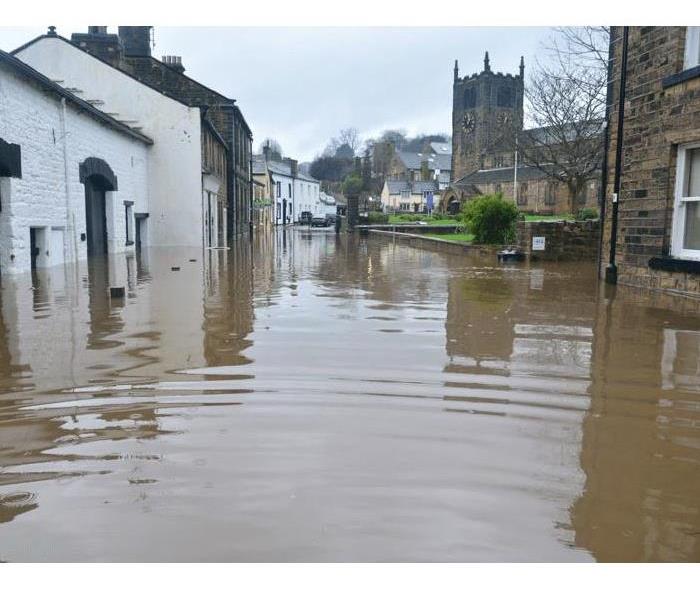 Water Flood
Water Flood
How to Stay Safe During a Flood
Water can enter your home during a storm and cause flooding, which can seriously harm your property. However, ensuring the protection of your immediate family, pets, and other loved ones should always come first. When the weather is safe, return to inspect the damage and start the cleanup once the storm has passed. When visiting the floodplain, avoid doing the following things:
Keep Your Hands Off the Water.
Numerous forms of contaminants, such as bacteria, viruses, chemicals, and debris, can be found in floodwater. Wearing rubber boots, gloves, and avoiding getting your hands or face wet will help protect your skin from the damaging effects of the water. If, in spite of your best efforts, contact happens, wash right away with soap and fresh water.
Never step into standing water.
Homes, yards, roadways, and other locations may have standing water after a flood. It is not unusual to see downed powerlines following a storm because strong winds frequently accompany intense storms. You can't always discern what's underneath the surface because floodwater is typically murky. If you enter a flooded home, you can get an electric shock if the water has been electrically charged. The risk of electrocution will be reduced with the use of rubber boots.
Don't let the water stand still.
Bacteria have more time to grow the longer water sits. The structural integrity of objects might start to deteriorate if they are submerged in water over extended periods of time. As quickly as possible, the water should be carefully evacuated. You can limit any water damage to your home by clearing the water more quickly. As soon as the water has been removed from the area, you should start the drying process because mould can start to form in as little as 24 to 48 hours.
By following a few precautions, you can help keep yourself safe from the dangers of floodwater.
Advice on what to do after facing water flood
6/7/2022 (Permalink)
Floods in your building can be terrible; we understand how stressful and frustrating this can be. However, there are certain things you can do in the first 24 hours after a flood if you follow our advice.
- Take photos of the damage before removing any water. This will help your insurer understand the extent of the damage.
- Protect Your Health: Sewage or home chemicals could contaminate the water. Wear rubber gloves if you plan on lingering near the water.
- Contact your insurance provider: Notify your insurance company as soon as possible after the flood. Keep the phone numbers of your insurance company and local agent in your phone for emergencies.
- Remove Water: Once your insurer has given you permission to do so, utilise a sump pump and contact a restoration business.
- Mold can develop in as little as 24 to 48 hours after a flood. Make sure to rapidly remove any moist contents, such as carpets and bedding.
Flooding at your home or company necessitates the assistance of an expert. To get it repaired as soon as possible, contact your local restoration firm.
Water Damages and it's consequences
5/28/2022 (Permalink)
With the temperatures rapidly rising and the hot summer season rapidly approaching, our natural impulse is to crank up the air conditioning indoors!
Even throughout the summer, though, the potential of water damage remains a concern.
If air conditioning units are not properly maintained, they might cause drainage problems. Make sure you change your air filter on a regular basis to avoid this. Regular inspections and cleanings are also necessary to avoid any problems in your unit from becoming worse. The drainage pan is one thing to keep an eye on. Make sure there isn't any water seeping and gathering in the pan. Mold, mildew, and fungus may quickly grow and spread, especially in hotter conditions.
Another factor to consider is the possibility of pipes bursting. Although burst pipes are more common in the winter, they can still cause a nightmare for a house or property owner in the summer. Whenever your water pressure changes, it's a good idea to pay attention. While it could simply be an annoyance, it could also be a sign that something more serious is about to happen. This could be the result of corrosion, which causes leaks and, eventually, water to enter your house or office.
The possibility of pipes bursting does not end there. If you observe cracks emerging on the walls, especially around the corners, it's reasonable to presume your foundation has changed. However, watering the soil on a regular basis and even planting plants around the foundation perimeter is a simple remedy. Plants can help to regulate soil temperature and can also keep the ground together with their roots.
Water damage is the last thing any homeowner or business owner wants to deal with, regardless of the weather!
Dealing with water Damage. Calling nearest SERVPRO!
5/27/2022 (Permalink)
What to Expect When Hiring a Water Damage Restoration Company
We will send a team of courteous, knowledgeable service technicians and leaders to your home when you contact us to analyse the nature of your problem. We'll do a thorough inspection and assessment of your property, taking careful note of all damage and possible trouble locations. If the source of the water intrusion is not evident, we locate it and repair it. To employ a proper and safe extraction procedure, we must first analyse the water to see if it is contaminated (such as Black Water from a sewage backup or groundwater incursion). We offer you with a thorough estimate of the cost once we have performed this initial diagnosis. We'll even assist you with filing an insurance claim.
How Do We Handle Water Damage?
Once water damage has occurred, begin the process of finding a solution as soon as feasible. This entails enlisting the help of a professional cleanup and restoration company to remove all of the undesirable water from the structure. To quickly distribute water, we have truck-mounted pumps and portable extractors. With the help of air movers and dehumidifiers, both desiccant and refrigerant, our Applied Structural Drying Technicians (ASD) can dry out your home. Our IICRC-certified WRT-Water Damage Restoration Technicians follow IICRC cleaning guidelines. We make sure the impacted regions are dry by using moisture metres, infrared cameras, and hygrometers.
WATER DAMAGE: THE SCIENCE OF DRYING Water
2/22/2021 (Permalink)
When faced with water damage, we might instinctively reach for towels to dry the wet. We might add fans to aid the process. However, there is actually a science to the drying process. The knowledge of psychrometrics, the dynamics of moist air, is critical to lower the chances of secondary damages. Your IICRC certified and trained technicians at SERVPRO of East San Antonio know the steps to take when your business or residence experiences water damage:
- First, we’ll conduct an inspection to detect what material(s) are wet
- Next, we’ll measure how much moisture is in those wet components and monitor whether the materials are drying properly.
- Additionally, we’ll "speed up" the process by using professional drying equipment. While a wet building can often dry naturally, it might do so unevenly, inadequately, or might take too long…all allowing for secondary damages to occur.
SERVPRO of East San Antonio has the knowledge, advanced equipment, and the technology, DryBook (a proprietary tool that provides real-time documentation, updates on the drying process, and confirms industry drying requirements are met) to ensure that your water damage is mitigated. We’ll make it “Like it never even happened.”
Water Damage can be unexpected
2/22/2021 (Permalink)
SERVPRO of East San Antonio is available 24 hours a day for water emergencies, large or small. When you are dealing with water damage, immediate action is crucial. A delay of just a few hours can greatly increase the severity of the water damage.
We understand that when you call us, you may be feeling confused, stressed, and vulnerable. You need an expert to guide you through this crisis. SERVPRO of East San Antonio has specific water damage training and experience to help you through this tough time. We specialize in water damage restoration—in fact, it is the cornerstone of our business.
What to Expect
When you call us, we will ask questions regarding your water damage emergency. These questions will help us determine what equipment and resources to bring. This includes how many trained SERVPRO professionals we may need.
Our SERVPRO of East San Antonio Representative will ask questions:
- Your name and contact information
- Your insurance information (if applicable)
- The street address of the water-damaged home or business
- When did the flooding or water damage occur?
- What caused the water damage (if known)?
- Is there electricity available (on-site)?
We're faster to any Water disaster
2/22/2021 (Permalink)
SERVPRO of East San Antonio provides 24/7/365 fire and water damage restoration service.
We do not wait for regular business hours. SERVPRO of East San Antonio provides emergency cleaning and restoration services 24 hours a day, 7 days a week—including all holidays.
Faster To Any Size Disaster
Flooding and water damage are invasive. Water quickly spreads throughout your home and gets absorbed into floors, walls, furniture, plus more. SERVPRO of East San Antonio arrives quickly and starts the water extraction process almost immediately. This immediate response helps to minimize the damage and the cleaning and restoration costs.
Water quickly spreads throughout your property, saturating everything in its path.
Water is absorbed into walls, floors, upholstery, and belongings.
Furniture finishes may bleed, causing permanent staining on carpets.
Photographs, books, and other paper goods start to swell and warp.
Hours 1 - 24:
Drywall begins to swell and break down.
Metal surfaces begin too tarnish.
Furniture begins to swell and crack.
Dyes and inks from cloth and paper goods spread and stain.
A musty odor appears.
48 Hours to 1 Week:
Mold and mildew may grow and spread.
Doors, windows, and studs swell and warp.
Metal begins to rust and corrode.
Furniture warps and shows signs of mold.
Paint begins to blister.
Wood flooring swells and warps.
Serious biohazard contamination is possible.
More Than 1 Week:
Restoration time and cost increase dramatically; replacing contaminated materials and structural rebuilding may be extensive.
Structural safety, mold growth, and biohazard contaminants can pose risks to occupants.
FAQ: I AM A RENTER-WHO WILL PAY FOR THIS WATER DAMAGE REPAIR?
1/20/2021 (Permalink)
At SERVPRO of East San Antonio, we have the opportunity to work on many water damage properties where multiple parties are involved. We often have renters, homeowners, property managers, and HOAs on a single water damage repair. Each project is unique when it comes to water restoration for condos or homes. Renters are responsible for their belongings, except in rare cases where the landlord's policy covers rental belonging. If a renter has a rental insurance policy, the policy may cover damaged contents (furniture, clothing, personal items), temporary housing if needed, or cleaning your belongings. The homeowner is responsible for the structure of the property. HOAs may be responsible for some of the structural repairs, depending on how the association bylaws are written.
Part of our job at SERVPRO of East San Antonio is to guide you through this process. We do water damage repairs every day, 24/7, so it is our pleasure to help you recover after a water emergency. Our team is trained to help you file a claim and communicate with your landlord and property manager. Please call SERVPRO of East San Antonio at (210) 757-0275 and we will help you with the water damage repair at your condo, home, or business.
WATER DAMAGE: THE SCIENCE OF DRYING
1/20/2021 (Permalink)
The Science of Drying
When faced with water damage, we might instinctively reach for towels to dry the wet. We might add fans to aid the process. However, there is actually a science to the drying process. The knowledge of psychometrics, the dynamics of moist air, is critical to lower the chances of secondary damages. Your IICRC certified and trained technicians at SERVPRO of East San Antonio know the steps to take when your business or residence experiences water damage:
- First, we’ll conduct an inspection to detect what material(s) are wet
- Next, we’ll measure how much moisture is in those wet components and monitor whether the materials are drying properly.
- Additionally, we’ll "speed up" the process by using professional drying equipment. While a wet building can often dry naturally, it might do so unevenly, inadequately or might take too long…all allowing for secondary damages to occur.
SERVPRO of East San Antonio has the knowledge, advanced equipment, and the technology, DryBook (a proprietary tool that provides real-time documentation, updates on the drying process, and confirms industry drying requirements are met) to ensure that your water damage is mitigated.
We’ll make it “Like it never even happened.”
Our 6-Step Process for Water Damage Restoration | SERVPRO® of East San Antonio
12/14/2020 (Permalink)
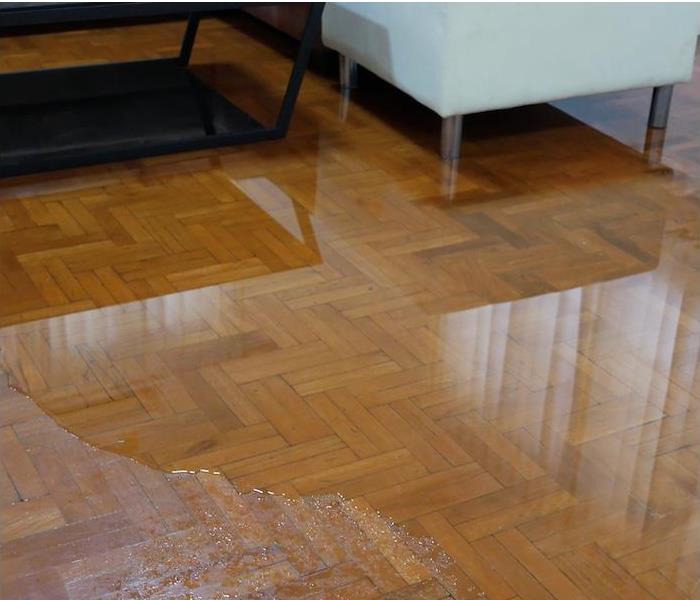 When dealing with water damage, immediate action is crucial. Contact SERVPRO of East San Antonio for prompt & dependable service
When dealing with water damage, immediate action is crucial. Contact SERVPRO of East San Antonio for prompt & dependable service
There is never a good time to sustain water damage, but it is important to quickly take actions for restoration even though it is an overwhelming scenario.
To help you deal with the aftermath, we are here at any hour to set our six-step process for water damage restoration in motion.
6 Steps to Water Damage Restoration
1. Initial Emergency Contact
Because disasters never stick to a schedule, you can call us at any hour to set the water damage restoration process in motion. We will discuss the damage with you over the phone to set a response plan in motion and dispatch our technicians to you as quickly as we can.
2. Inspection and Damage Assessment
Once we arrive on the scene of the damage, we will first make sure the area is safe and turn off any water flow that might be contributing to the damages. From there, a complete inspection will be completed and a restoration plan will be drafted and reviewed with you.
3. Moisture Extraction
We always move to extract moisture as quickly as possible, as this is the best method for preventing excessive damages. We have equipment that can pump out hundreds of gallons of water at a time, so there is no job that is too large for us to handle.
4. Dehumidifying and Drying
After the majority of standing water has been removed, we can bring in our dehumidifiers and dryers to further speed the process along. These will help remove moisture absorbed by your home’s porous surfaces and stop mold from causing even more damage to your belongings and home.
5. Cleaning Belongings
It is important to thoroughly clean items that have come into contact with excess moisture to keep them in good (and safe) condition. We will thoroughly clean all impacted items and surfaces in your home which will prevent deterioration and the development of odors.
6. Restoration and Repair
We want you to have a home or office that is restored fully to the condition it was in before the water damage occurred, which is why we also handle repair work as part of our restoration. From installing new carpets to painting over drywall patches, we make sure that you are fully set up with a complete restoration before we leave.
If your home has been water-damaged, you can count on us to help. Call us 24⁄7 to get the process started.
Heavy Rainfall Can Lead to Household Water Damage | SERVPRO® of East San Antonio
12/14/2020 (Permalink)
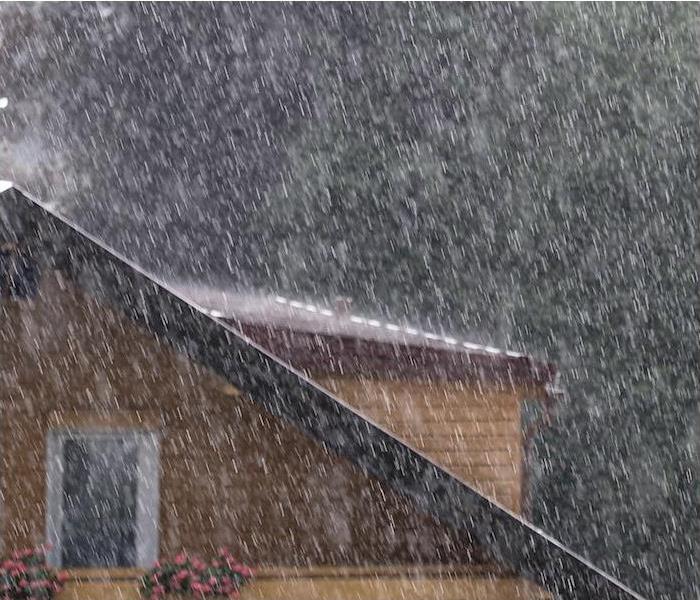 Heavy rains can cause serious water damage. SERVPRO of East San Antonio has the trained technicians to fully restore your home.
Heavy rains can cause serious water damage. SERVPRO of East San Antonio has the trained technicians to fully restore your home.
The rushes of floodwater or sprays from burst pipes are generally what comes to mind when water damage is mentioned, but less dramatic events such as steady, heavy rain showers are common culprits of damage as well.
When your home’s defenses are not strong against the weather, heavy rain can easily work its way in—here are some of the common places we see this happen:
Where We Often See Leaks Caused by Heavy Rainfall
Backup of clogged gutters. The debris that builds up in gutters is more than just an inconvenience—it can cause water damage as well. When heavy rains come through and the water cannot drain via the gutters, pools of water can begin to seep into the roofline.
Leaks around windows and doors. Small openings between doors and windows and the exterior walls of the home might not be visible to the naked eye, but water can quickly find its way in. Weather-stripping is a great addition around exterior openings to prevent this.
Poor drainage around the foundation. If heavy rain leads to water building up around your foundation, it is wise to install landscaping or other drainage systems that can help to move this water away. Standing water can seep into the home’s foundation and cause serious damages otherwise.
Leaks in and around the roof. Roof leaks have a way of sneaking up on homeowners, so doing work to prevent them is better than waiting until they become evident. Look out for peeling sealants or missing shingles, as heavy rain can quickly exploit these small issues and create a big leak.
Malfunctioning of a sump pump system. Sump pumps are great for maintaining moisture levels in damp spaces, but without proper maintenance, they can malfunction and cause their own issues in the area they were installed to protect.
Leaks around chimneys and skylights. Homes that have features that intersect with the roof, such as skylights and chimneys, are more vulnerable to leaks from heavy rains. The seals around these features can deteriorate over time, so inspect them regularly for weaknesses.
If you’ve experienced water damage to your home, we are here to help. You can call us 24⁄7 to have our trained technicians respond quickly and begin your restoration.
3 Steps To Recover From Kitchen Water Damage in San Antonio, TX
11/14/2019 (Permalink)
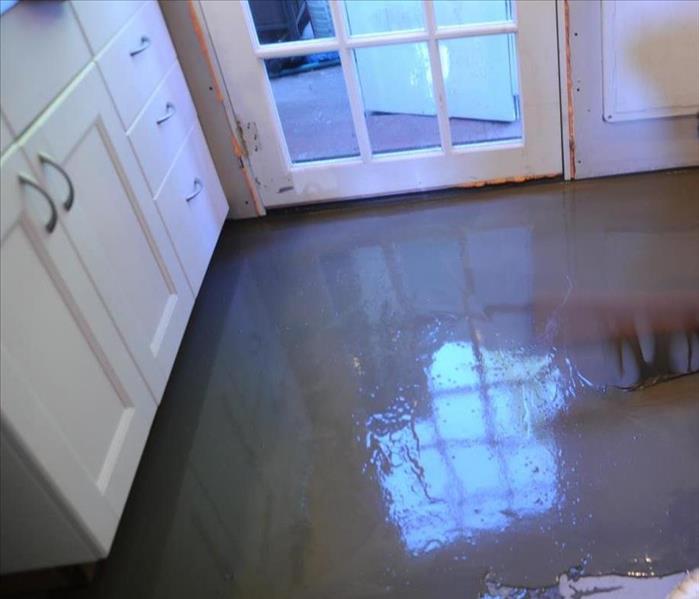 San Antonio kitchen flooded from pipe leak
San Antonio kitchen flooded from pipe leak
When you find a leak in your kitchen, many details should be handled quickly to minimize the damage flooding can cause. Though it may seem overwhelming, following these steps can help save your property and return your kitchen to its undamaged state.
Shut Off the Water and Assess Your Safety
The first step when you have a leaky kitchen sink is to turn off your water. Check underneath the sink to start. There will probably be stop valves there (one for hot water and one for cold), which you can turn clockwise to stop the water from flowing to the sink.
Once you've stopped the active seepage, you should make sure the environment is safe. The most common concerns after kitchen floods are slip-and-fall incidents and electrical hazards. Also remember that wet materials can be extremely heavy. Exercise caution when removing damaged items.
Call Your Insurance Company
You should call your insurance company when dealing with flooding in your residence. There are several types of water-related disasters, but for insurance purposes, there are only three categories of damage. Talking with restoration professionals can give you the details your insurance agent needs during the claims process.
Call in the Professionals
Depending on the severity of your leak, damage can include ruined floors, cabinets, or appliances and can lead to mold or rot. These problems are more likely to linger if they aren't handled correctly from the start. A cleanup and restoration company can make recovering from emergencies from water in the home more manageable. A trained expert typically uses a scientific approach and powerful technology to help with every step. Restoration services may include evaluating damage, moisture extraction, drying, dehumidification, sanitizing, and kitchen repair.
If you feel daunted by the prospect of repairing your kitchen after flooding in San Antonio, TX, hire a skilled restoration company. By approaching the repairs methodically and using an array of impressive tools, experts can return your home to its pre-damage condition more quickly.
For more information or to set an appointment fell free to contact us at 210-757-0275 or at https://www.SERVPROeastsanantonio.com/
3 Steps To Stop a Toilet From Overflowing in San Antonio,TX
11/14/2019 (Permalink)
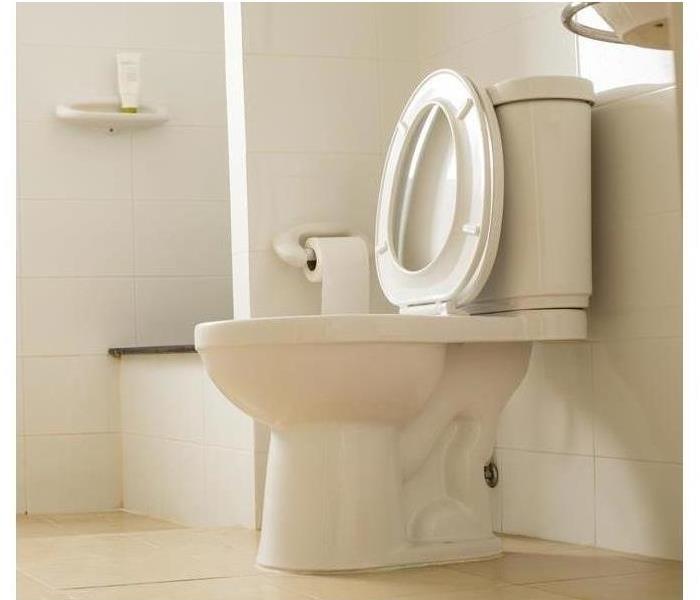 Possible Source in San Antonio fro sewer back up
Possible Source in San Antonio fro sewer back up
3 Steps To Stop a Toilet From Overflowing
A drain line blockage can result in a flooded toilet. Homeowners can take three steps to stop a toilet from overflowing and limit the extent of sewer damage at a residence in San Antonio, TX.
1. Contain Damage
Contaminated water can cause major water damage. If this water sinks into carpet or porous building materials such as drywall, these materials will likely need to be torn out and replaced. Use towels or a mop to stop the spread of sewage backup.
2. Use a Plunger or Snake
Once a homeowner has taken measures to try to stop the spread of Sewage Water, he or she should address the cause of the problem. If the backup is due to a minor clog close to the floor drain, plunging a toilet may be enough to clear the clog and stop the overflow.
If the clog is more severe, insert an auger or snake into the toilet. Some augers have hand cranks while others can be attached to a power drill. It may be more effective to remove the toilet and snake the floor drain directly. You will need to use specialized tools and remove water from the bowl and tank or use a solidifying gel. Clear deeper clogs by snaking the drain cleanout in a basement or crawlspace.
3. Contact a Plumber
Calling a plumber can be easier than removing a toilet or dealing with a drain cleanout. If you do not have a snake or the skill or tools necessary to attempt advanced plumbing techniques, a trained professional is your best bet. If the problem originates in a municipal main, contact a sewage company.
If a flooded toilet causes extensive sewer damage, a homeowner should contact a water damage mitigation and restoration company located in San Antonio. Experts can remove damaged materials, promote drying to prevent mold and restore the affected area.
For more information or to set an appointment fell free to contact us at 210-757-0275 or at https://www.SERVPROeastsanantonio.com/
Don’t Come Back From Vacation to Find Your San Antonio Home Flooded
11/13/2019 (Permalink)
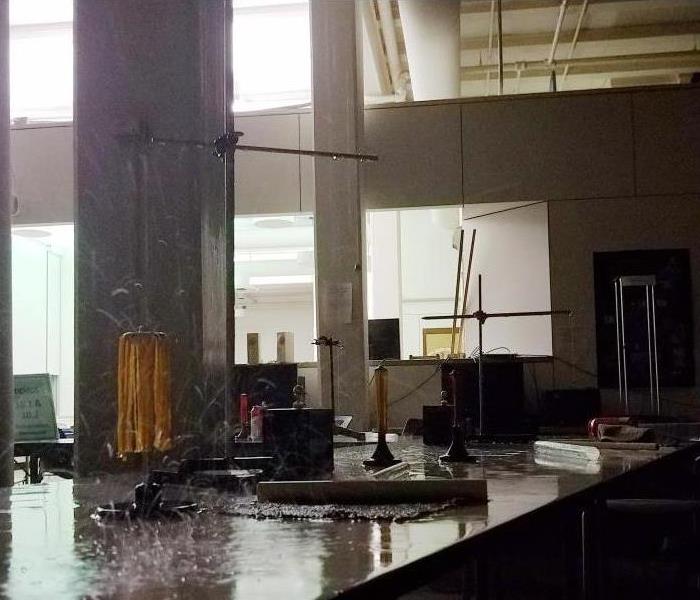 Water loss over the weekend, San antonio, TX, Bexar County
Water loss over the weekend, San antonio, TX, Bexar County
The last thing that should be on your mind when you’re on a vacation away from San Antonio, TX is whether a broken pipe has caused an area of your home to flood. This can cause damage to your belongings and your home, so the best thing to do is to prevent the need for water pipe repair.
Prevent Burst Pipes
Broken pipes can be difficult to fix, and the damage can be costly. It’s best to keep this issue from ever happening. If you’re traveling out of town for an extended period of time, specifically during the winter, there are several steps you can take to prevent your home from being flooded:
• Don’t turn down the heat too far. If you keep the heat on, even if you turn it lower than if you were home, it can keep your pipes warm enough to prevent them from freezing.
• Keep the water running. You don’t have to run the water on full. If you allow the faucet to drip, this helps relieve the pressure in your water system, possibly eliminating water pipe repair.
• Wrap the pipes. If you wrap pipes, especially those that are exposed, with towels or blankets, it provides extra insulation against the elements.
Keep an Eye on Your Home From a Distance
If you’re going to be gone for several days, especially during the coldest parts of winter, it’s not a bad idea to have a neighbor, family member or friend stop by the house once in a while. This can be just a quick peek inside to verify there is no flooding or a broken pipe, or checking the thermostat to make sure plenty of warm air is circulating in your empty home.
You can also use video cameras that you can view from your phone or computer to check on your home. This won’t prevent a pipe from bursting, but it can allow you to at least get a professional there to do a water pipe repair sooner and prevent further damage.
For more information or to set an appointment fell free to contact us at 210-757-0275 or at https://www.SERVPROeastsanantonio.com/
3 Ways a Hot Water Heater Leak Can Damage Your San Antonio Home
11/12/2019 (Permalink)
An old water heater can cause major problems in your San Antonio home
While hot water heaters are some of the most durable appliances in your home, when they fail, they fail big. From damaging floors and furniture to triggering mold growth, a leaking water heater can cause untold headaches and expense in your San Antonio, home. Don’t think it’s worth keeping up maintenance on your water heater? You may change your mind when you read these three ways a failed water heater can damage your San Antonio home.
Why Water Heaters Fail
Water heaters often become less and less efficient, until the problem is very clear. This gradual failure is often the result of a buildup of problems like:
- Calcification from accumulating sediments
- Internal rust
- Corrosive fumes
- Old age
Whatever the cause, anything that creates a leak from your broken water heater can cause major problems.
Mold Growth
Whenever there’s a leak from an appliance, mold growth is a potential result. A leaking water heater is no exception. Water can begin to grow on floors or even walls around your heater as spores find their way to excess moisture and multiply. Beyond degrading air quality, mold can cause odors, stains and generally destroy drywall.
Damaged Surfaces
Damage from a water heater leak isn’t limited to mold. Water pooling on floors can lead to warped or buckling surfaces. Humidity and condensation, meanwhile, can cause paint on walls to peel and bubble, destroying the look of your walls.
Ceiling Damage
In cases where a hot water heater is located on an upper floor, a leak can cause ceiling damage. This is because water will seek the lowest point, dripping into the floor and pooling through the ceiling on the next level.
Depending on the circumstances, a leaking water heater can cause as much damage as a minor household flood. Don’t be a victim. Talk to a qualified our water restoration specialist to learn your options. You’ll save big in the long run.
Recovery From Water Damage in Bexar County
11/12/2019 (Permalink)
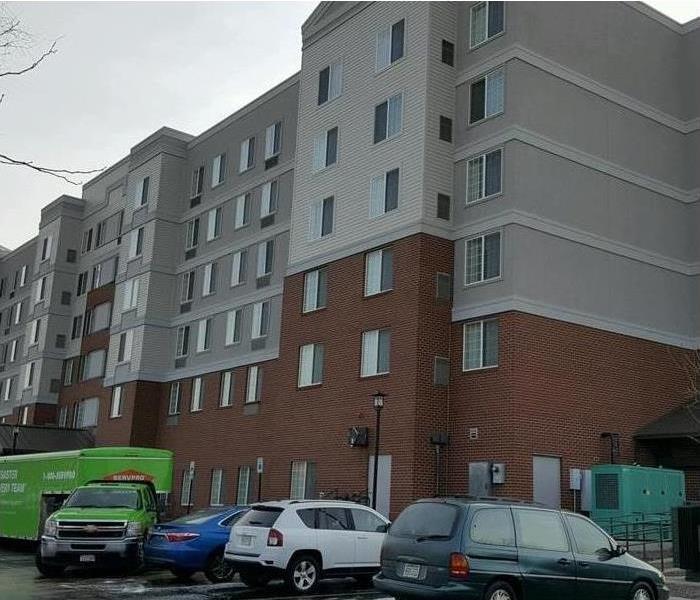
Whether it's flood damage due to torrential rains or a busted pipe, water damage is serious business! The first thing to know is how to start the cleanup and mitigation process so that you can get full water damage restoration.
Water in home or water in business can make people ill if the water damage is left untreated, so water cleanup in quick time is required. The drying process must start right after the building is safe to enter. This is not ordinary drying, as regular air movement will not get the job done. There is a method to structural drying water damage in home or water damage in business.
First, be sure to start the flood damage cleanup by emptying the contents of the home or office. Some items may be salvageable after water in your home or water in your business; however, you have to remove the items contaminated by water damage to start the water cleanup process.
Once the building is emptied of contents, industrial size fans can help circulate air movement to assist the drying process. Air movement is essential to slow down the growth of mold. Using fans to conduct air movement will also help the building smell better, as flood damage odors are awful. It's a race against time when water in your home or water in your business. The faster you clear the area after flood damage, the more effective the overall chances for complete water damage restoration and mitigation.
If the flood damage resulted in inches of water in your home, you will need to relocate temporarily. If the water is in your business you may need to set up an office elsewhere while the water damage restoration is being completed. Yes, it is difficult to relocate but until the home of office has undergone total mitigation, the air may still be carrying mold despite best measures taken during cleanup. Just because there is air circulation it does not mean the air is yet safe to breathe.
Water damage restoration is a big job, and it's best to call in professionals who are experts at water damage mitigation. The water damage repair process starts with drying our walls, floors, and contents. Flood mitigation experts use structural drying techniques that may save some of your possessions. These water cleanup experts can also test for mold and use moisture detectors to see how far the flood damages has gone. An expert plan can then be made to finish the water cleanup and restore your home of business completely.
The entire water cleanup process does take a little time and patience; however, the faster you call as water damage restoration company, the quicker the recovery. Visit https://www.SERVPROeastsanantonio.com/ for more information on water damage
Restoration Doesn't Have to be Scary
10/17/2019 (Permalink)
 Restoration doesn't have to be scary! Call SERVPRO of East San Antonio!
Restoration doesn't have to be scary! Call SERVPRO of East San Antonio!
Nobody ever wants to deal with fire damage, storm damage, water damage, or mold damage. Nobody wants those sorts of losses to happen to their home or business. Unfortunately, these types of damages happen every day.
While there is no avoiding the stress that comes with experiencing these situations, SERVPRO of East San Antonio is here to help. With over two decades' experience in the restoration industry, we want to help you navigate the mitigation process so that you know what to expect. We will explain what steps will be taken in restoring your property, and hopefully help alleviate any concerns or fears you might have by doing so.
We are passionate about making it "Like it never even happened." Should you suffer a water, fire, storm, or mold loss at your home or business, please call SERVPRO of East San Antonio.


 24/7 Emergency Service
24/7 Emergency Service

